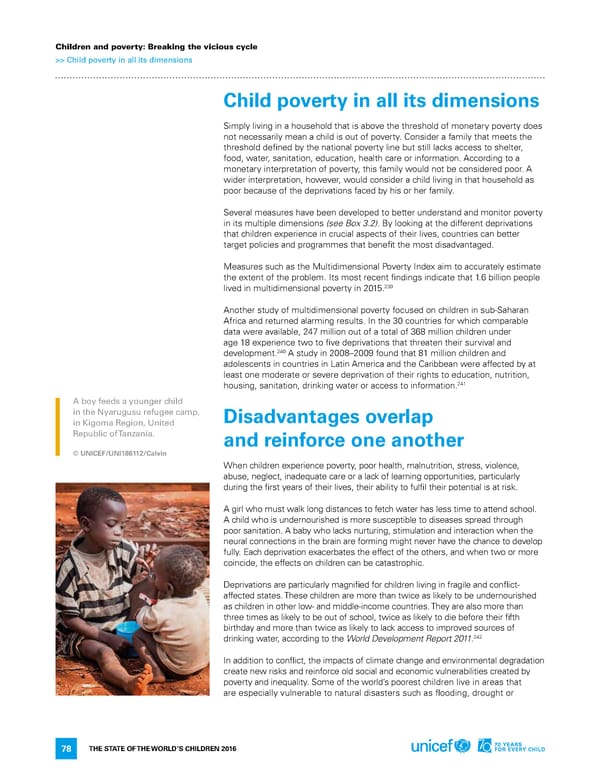Children and poverty: Breaking the vicious cycle >> Child poverty in all its dimensions Child poverty in all its dimensions Simply living in a household that is above the threshold of monetary poverty does not necessarily mean a child is out of poverty. Consider a family that meets the threshold defined by the national poverty line but still lacks access to shelter, food, water, sanitation, education, health care or information. according to a monetary interpretation of poverty, this family would not be considered poor. a wider interpretation, however, would consider a child living in that household as poor because of the deprivations faced by his or her family. Several measures have been developed to better understand and monitor poverty in its multiple dimensions (see Box 3.2). By looking at the different deprivations that children experience in crucial aspects of their lives, countries can better target policies and programmes that benefit the most disadvantaged. Measures such as the Multidimensional Poverty index aim to accurately estimate the extent of the problem. its most recent findings indicate that 1.6 billion people 239 lived in multidimensional poverty in 2015. another study of multidimensional poverty focused on children in sub-Saharan africa and returned alarming results. in the 30 countries for which comparable data were available, 247 million out of a total of 368 million children under age 18 experience two to five deprivations that threaten their survival and 240 development. a study in 2008–2009 found that 81 million children and adolescents in countries in latin america and the Caribbean were affected by at least one moderate or severe deprivation of their rights to education, nutrition, 241 housing, sanitation, drinking water or access to information. A boy feeds a younger child in the Nyarugusu refugee camp, Disadvantages overlap in Kigoma Region, United Republic of Tanzania. and reinforce one another © UNICEF/UNI186112/Calvin When children experience poverty, poor health, malnutrition, stress, violence, abuse, neglect, inadequate care or a lack of learning opportunities, particularly during the first years of their lives, their ability to fulfil their potential is at risk. a girl who must walk long distances to fetch water has less time to attend school. a child who is undernourished is more susceptible to diseases spread through poor sanitation. a baby who lacks nurturing, stimulation and interaction when the neural connections in the brain are forming might never have the chance to develop fully. each deprivation exacerbates the effect of the others, and when two or more coincide, the effects on children can be catastrophic. deprivations are particularly magnified for children living in fragile and conflict- affected states. These children are more than twice as likely to be undernourished as children in other low- and middle-income countries. They are also more than three times as likely to be out of school, twice as likely to die before their fifth birthday and more than twice as likely to lack access to improved sources of 242 drinking water, according to the World Development Report 2011. in addition to conflict, the impacts of climate change and environmental degradation create new risks and reinforce old social and economic vulnerabilities created by poverty and inequality. Some of the world’s poorest children live in areas that are especially vulnerable to natural disasters such as flooding, drought or The STaTe of The World’S Children 2016 78
 70 Years for Every Child Page 94 Page 96
70 Years for Every Child Page 94 Page 96